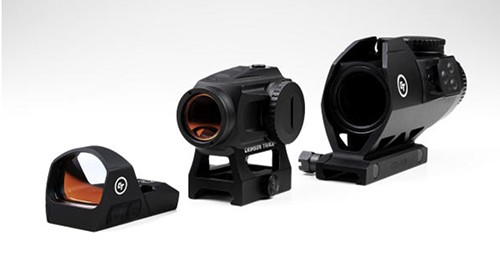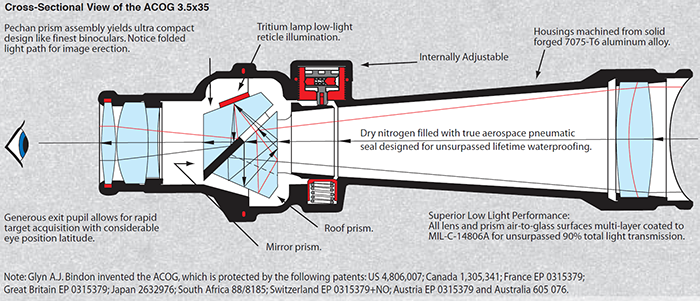They are all just red dots, right?
All too often this is the way we tend to think of non-magnified optics (red dots). And while not too far off, this idea doesn’t capture some of the smaller differences between reflex sights, prism sights, and holographic sights that the manufacturers probably wish we all knew. So what’s the difference and why do you, as a shooter, care? Well, I’ll do my best to explain; so here we go!

Reflex Sights
First up, reflex sights. Most commonly known as red dot sights, these optics are exactly what you expect when you think of a red dot. Usually a tube or single pane of plastic or glass these sights are simplistic and effective. They work by having a small LED, usually red, at the rear of the optic that is pointed towards the front lens. The backside of the front lens is reflective, sending the reflection of the led back at your eye, and voila, you see a small red dot through the optic.
The Pros:
- Unlimited eye relief: No matter how far away the optic is or how close it is to your eye, everything works just fine as long as you can see the dot.
- Small size: Red dots come in small, lightweight packages.
The Cons:
- No magnification
- Limited Reticle options
- No etched reticle: If the battery dies or the electronics go out, the optic is useless.
Prismatic Sights
As the name implies, these sights make use of a prism to reflect and fold the light passing through the optic before it reaches the eyepiece. These compact sights are much smaller and shorter than standard variable scopes, but usually larger than reflex sights.

The Pros:
- Etched Reticles: Regardless of battery power, these sights will always have a visible reticle for use.
- Multiple reticle options.
- Multiple magnification options: While there are no variable power prism optics, you can get these sights in a variety of fixed magnifications. Usually from 1x to 5x.
The Cons:
• Limited eye relief: Because of the lenses and prisms used, you have to set the optic the correct distance from your eye.
• Larger size and heavier weight when compared to typical reflex sights.
Holographic Sights
Probably the coolest, but most complex of the ‘red dots’ on the market today is the holographic sight. This optic has been championed by EOTech and for many; the name is synonymous with holographic sights. These sights use a laser that projects onto a series of lenses and reflectors to produce a visible hologram within the sight.
Pros:
- Always on target: The holographic sight is always pointed where the rifle is pointed, even when the shooter’s head is not aligned with the optic.
- Multiple Reticle Options.
- Small dot sizes
- Large field of view: compared to the other optics discussed here, holographic sights generally have the largest field of view.
- Magnification: When used in conjunction with a magnifier, the dot size remains the same. E.g. with a 3x magnifier 1MOA is 1MOA, not 3MOA as it would be with a reflex sight.
- Unlimited eye relief
Cons:
- No etched reticle
- Cost: of the optics discussed here, holographic sights tend to be the most expensive. Commonly twice the price of many decent reflex sights.
Summing Up Red Dots
So which should you choose and why? Well, that’s a question that only you can answer. But with all the information, you can narrow down your choice based on your specific needs. Want more help making that choice? Hit us up anytime and we’d be thrilled to talk through your options and application with you!
